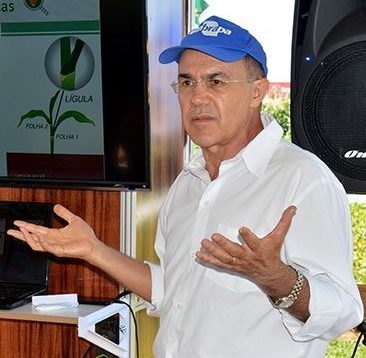“Currently, co-inoculation in corn has shown promising results, largely due to the fact that rhizobacteria acts in the development of roots…”
Paulo Cesar Magalhães is a researcher at Embrapa Corn & Sorghum, has a degree in agronomy from the Federal University of Lavras, a M.Sc. from the Federal University of Viçosa and the University of Minnesota, and a Ph.D. from Mississippi State University.

Paulo Magalhães, researcher at Embrapa
AgriBrasilis – Is corn co-inoculation a good option to mitigate situations of water stress? Why?
Paulo Magalhães – Yes. Currently, co-inoculation in corn has shown promising results, largely due to the fact that rhizobacteria acts in the development of root architecture, altering its morphology, causing better use of water and nutrients. The microorganisms involved in co-inoculation are responsible for the production of phytohormones that regulate plant growth, increasing the ability of roots to extract water and nutrients from the soil.
AgriBrasilis – Can the use of hybrid cultivars be advantageous to farmers in this scenario?
Paulo Magalhães – Yes, hybrids are materials that have undergone improvement to tolerate various types of stress. They have leaves and roots capable of producing enough carbohydrates for good grain filling, even under stress conditions. Currently, there are breeding programs seeking to identify drought-tolerant hybrids.
“The microorganisms involved in co-inoculation are responsible for the production of phytohormones that regulate plant growth, increasing the ability of roots to extract water and nutrients from the soil”
AgriBrasilis – What other options are there to reduce the effects of drought on the crop?
Paulo Magalhães – In addition to the use of hybrids, cultural practices are important and starts with the correct sowing time. When planting in the off-season is delayed, due to the harvest of the previous crop, the chances are high that the corn crop will suffer from a lack of water at critical times, such as during flowering.
AgriBrasilis – What are the main symptoms of water stress in corn crops?
Paulo Magalhães – Reduction of growth and development, shortening of internodes, wilted, yellowish leaves, causing accelerated senescence of the lower leaves. When stress occurs after flowering, the symptoms are a lack of grains on the corn’s ear and lower grain weight.
AgriBrasilis – What measures can farmers take in their crops?
Paulo Magalhães – Farmers should follow the recommendation of the AZCR (Agricultural Zoning of Climatic Risk) for the correct choice of planting time. In addition, choosing good seeds is fundamental. Nowadays, hybrids are recommended regionally: for each region, there are market options for the correct type of corn hybrid.
AgriBrasilis – How did the weather affect the corn plants in 2023?
Paulo Magalhães – Much of the corn currently harvested in Brazil comes from off-season sowing. Historically, during this period, climatic conditions are unstable: with scarce and poorly distributed rainfall, in addition to high temperatures in the central region of the country, and a lot of rainfall in the southern region, which can cause a delay in planting, subjecting the crop to abiotic stresses, especially water stress, causing a drop in grain yields.
Specifically in 2023, the weather contributed to a record grain harvest, with an increase in the planted area and in yields. In the critical phases of the crop (germination, flowering, and grain filling), in which the demand for water is essential, the weather was good, and there was no major reductions to yields.
AgriBrasilis – Which conditions can lead to to poor development of grains in corn cobs?
Paulo Magalhães – The poor development of grains in the cob is due to problems in fertilization or lack of floral synchrony, that is, the male flowering does not coincide with the female flowering, causing failures in the cob. Water deficit is an important factor for the increase between male and female flowering intervals. In this situation, the pollen tube in the cob makes it impossible to fertilize the grains, since water is a primary factor for fertilization to occur.
AgriBrasilis – What is the phenomenon of tassel seeds? Why does it occur?
Paulo Magalhães – Tassel seeds means that they are located in the tassel. This phenomenon can occur when there is tillering of the plant, or it can also be caused by stresses such as lack of water and/or high temperatures, which cause a hormonal imbalance in the corn plant, thus causing the appearance of seeds in the tassel. It is not common to occur in the field and, even if identified, it happens in only a few plants.
READ MORE:

